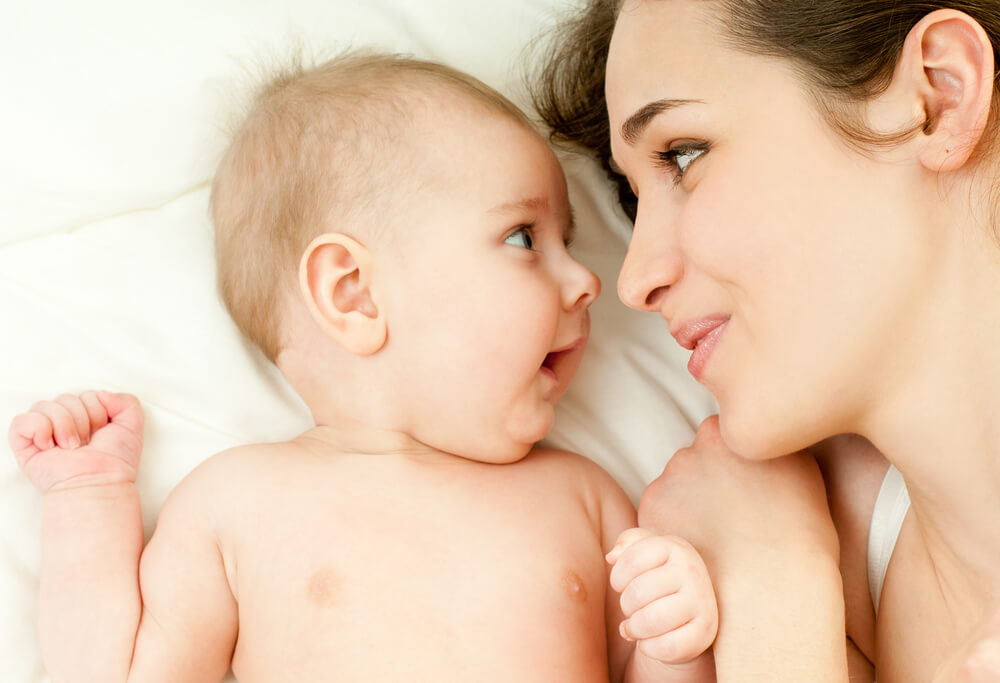Attachment Is Crucial For Your Baby

In this article we’ll explain what attachment is, and why attachment is essential for your baby’s physical and emotional development.
Babies need their parents in order to develop properly; they are more likely to develop behavior problems or anxiety if they’re separated from these figures.
Today parents are prioritizing natural and attachment parenting above all, since we know more about all the benefits that these have both for the baby and for their family relationships.
What is attachment?
Attachment is a special relationship that a child establishes with a small number of people.
It is an emotional bond which is formed between themselves and each of these people. This bond impels them to seek proximity and contact with these people over time.
This is also an innate mechanism through which the child seeks security.
Attachment behaviors become more relevant in situations that the child perceives as more threatening, such as pain, sickness, or fear.
Children use crying as one of the main mechanisms through which they get the attention of the attachment figure.

Attachment and Mothers
The emotional bond between the mother and the baby develops quickly, beginning even before the baby is born because the mother already feels it in her womb.
Mothers who are more sensitive to their babies’ needs and who adjust their behavior to them are more likely to establish a secure attachment with them.
These mothers will react quickly to the signs given by their children, such as giving them food, knowing when they are satisfied, and respecting their sleep-wake rhythms.
These mothers are perceived by the baby as loving, cheerful, and tender.
When faced with their crying child, they know how to comfort them in their arms.
Attachment and Fathers
Traditionally the child’s strongest attachment bond is established with the mother. Nowadays we are witnessing an increase of the father’s involvement in child care.
Reasons like working hours, the number of children, economic resources, etc, determine the need for co-responsibility on the part of both parents when it comes to caring for the baby.

What is attachment parenting?
This is a philosophy based on the principles of attachment theory and developmental psychology.
It proposes that there should be a safe emotional bond and synchronization between the parents when it comes to the child’s needs and capacities at each stage of development.
Attachment parenting promotes the following principles:
- Skin-to-skin contact
- Carrying babies
- Holding babies whenever necessary
- Co-sleeping
- Letting the baby feel the warmth of their parents and smell them
- Respecting the baby’s natural rhythms
- Not letting them cry or fall asleep alone
- Being able to identify their pains if they are sick
- Touching the baby
- Teaching children what they can and can’t do according to their abilities
- Understanding that children are not manipulative in the way that adults are
- Console them when they cry because they can’t have something
- Explain everything to them even if they may not understand it yet
Benefits of Attachment for Your Child
Human beings are born with the innate tendency to attach to a protective caregiver.
Attachment is the emotional bond between the child and their parents and plays a fundamental role in the regulation of stress in times of distress, anxiety, or illness.
The main benefits of attachment for your child include the following:
- Physical safety
- Emotional safety
- Stimulation of the senses
- Less crying
- Improved breastfeeding
- Higher self-esteem
- Better self-confidence
- Positive personal relationships
- The ability to overcome frustration
- Motivation to learn
- Success in school
- The ability to solve problems
We can emphatically affirm that spending time caring, interacting and paying attention to their baby is the best investment attachment figures can make to guarantee emotional stability for their child during their development.
In this article we’ll explain what attachment is, and why attachment is essential for your baby’s physical and emotional development.
Babies need their parents in order to develop properly; they are more likely to develop behavior problems or anxiety if they’re separated from these figures.
Today parents are prioritizing natural and attachment parenting above all, since we know more about all the benefits that these have both for the baby and for their family relationships.
What is attachment?
Attachment is a special relationship that a child establishes with a small number of people.
It is an emotional bond which is formed between themselves and each of these people. This bond impels them to seek proximity and contact with these people over time.
This is also an innate mechanism through which the child seeks security.
Attachment behaviors become more relevant in situations that the child perceives as more threatening, such as pain, sickness, or fear.
Children use crying as one of the main mechanisms through which they get the attention of the attachment figure.

Attachment and Mothers
The emotional bond between the mother and the baby develops quickly, beginning even before the baby is born because the mother already feels it in her womb.
Mothers who are more sensitive to their babies’ needs and who adjust their behavior to them are more likely to establish a secure attachment with them.
These mothers will react quickly to the signs given by their children, such as giving them food, knowing when they are satisfied, and respecting their sleep-wake rhythms.
These mothers are perceived by the baby as loving, cheerful, and tender.
When faced with their crying child, they know how to comfort them in their arms.
Attachment and Fathers
Traditionally the child’s strongest attachment bond is established with the mother. Nowadays we are witnessing an increase of the father’s involvement in child care.
Reasons like working hours, the number of children, economic resources, etc, determine the need for co-responsibility on the part of both parents when it comes to caring for the baby.

What is attachment parenting?
This is a philosophy based on the principles of attachment theory and developmental psychology.
It proposes that there should be a safe emotional bond and synchronization between the parents when it comes to the child’s needs and capacities at each stage of development.
Attachment parenting promotes the following principles:
- Skin-to-skin contact
- Carrying babies
- Holding babies whenever necessary
- Co-sleeping
- Letting the baby feel the warmth of their parents and smell them
- Respecting the baby’s natural rhythms
- Not letting them cry or fall asleep alone
- Being able to identify their pains if they are sick
- Touching the baby
- Teaching children what they can and can’t do according to their abilities
- Understanding that children are not manipulative in the way that adults are
- Console them when they cry because they can’t have something
- Explain everything to them even if they may not understand it yet
Benefits of Attachment for Your Child
Human beings are born with the innate tendency to attach to a protective caregiver.
Attachment is the emotional bond between the child and their parents and plays a fundamental role in the regulation of stress in times of distress, anxiety, or illness.
The main benefits of attachment for your child include the following:
- Physical safety
- Emotional safety
- Stimulation of the senses
- Less crying
- Improved breastfeeding
- Higher self-esteem
- Better self-confidence
- Positive personal relationships
- The ability to overcome frustration
- Motivation to learn
- Success in school
- The ability to solve problems
We can emphatically affirm that spending time caring, interacting and paying attention to their baby is the best investment attachment figures can make to guarantee emotional stability for their child during their development.
All cited sources were thoroughly reviewed by our team to ensure their quality, reliability, currency, and validity. The bibliography of this article was considered reliable and of academic or scientific accuracy.
- Barudy, J., & Dantagnan, M. (2005). Los buenos tratos a la infancia: Parentalidad, apego y resiliencia. Editorial Gedisa.
- Garrido-Rojas, L. (2006). Apego, emoción y regulación emocional. Implicaciones para la salud. Revista latinoamericana de psicología, 38(3), 493-507. https://www.redalyc.org/pdf/805/80538304.pdf
- Marrone, M., Diamond, N., Juri, L., & Bleichmar, H. (2001). La teoría del apego: un enfoque actual. Madrid: Psimática.
- Mosquera D, Gonzalez, A (2009) Escala de Apego y Patrones Relacionales.
- Mosquera, D., & González, A. (2013). Del apego temprano a los síntomas del trastorno límite de personalidad. Revista Digital de Medicina Psicosomática y Psicoterapia, 3(3), 1-33. http://www.psicociencias.com/pdf_noticias/Apego_y_TLP.pdf
- Shaffer, D. R., & del Barrio Martínez, C. (2002). Desarrollo social y de la personalidad. Madrid: Thomson.
This text is provided for informational purposes only and does not replace consultation with a professional. If in doubt, consult your specialist.








